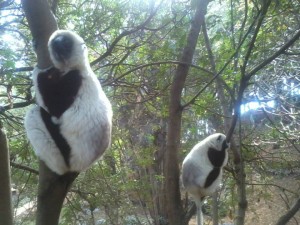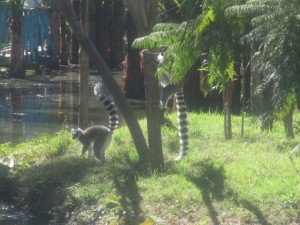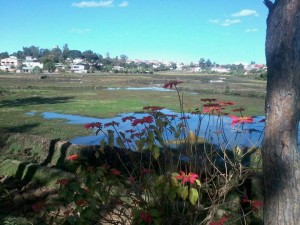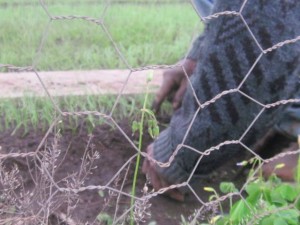Tropical and Protected
Forests as romanticized nature vs. everyday realities
Tropical forests have been an interest to me from a young age. Watching Zaboomafoo and Tarzan as a child leap from branch to branch to branch in a green world much inspired the adventurous side of me, such that I would walk around in my own forested backyard as if I were in a jungle.

“Primate Conservation and Local Communities— Ethical Issues and Debates”
Conservation can be ethically questionable in its representation of animal over human interests. Catherine Hill analyzes the costs and benefits of protection of the Greater Apes against human right protection. She questions whether one group has higher merit than the other and the implications of that attributed merit. Hill argues species protection and sustainable development can be reached through an interdisciplinary ethical approach.

Hill uses previous literature on primates from Uganda, Central and West Africa, and Asia. She discusses the ecological, economical, scientific, moral and cultural value of primates, then highlights the repercussions of protecting them. On one hand, primates are important to biodiversity, and their similarity to humans could extend human rights to them. On the other hand, Greater Apes may act as crop pests and spread diseases to humans. Their protection would imply regulations to a habitat used by locals for resources. Hill also questions the ethics of pairing conservation and development; depending on the actors and stakeholders, species conservation may be valued over “community development” or “community development” may be valued over species conservation.
Hill’s ethical questions reflect the binaries often set up between humans and animals. Delving deeper into the set boundaries for primates, humans, and plant species reveals protection can compromise the rights of the “other.” The frameworks she considers can be found in McNeil’s ethics article as well as in Nazarea’s “View From a Point.” The ethical standing or stake one has affects the discussion. Depending on how a problem is framed as being a problem, the accompanying solution will also be different.
Forests as spaces of control vs. spaces of protection
At the same time, forests have also stood as a place of fear for me. Many of the bedtime stories came from my Mende-Fulani father. In the stories I remember from him, woods and forests were where all the monsters lived (strangely, I lived for all these stories!). Even when multiple parties do agree forests are in need of protection, the source of management may not originate from a need to protect it but rather to control resources. Similarly, ideals of protection may call for reduced or increased human involvement.
“The Low-Wage Conservationist: Biodiversity and Perversities of Value in Madagascar”
Conservation in Africa is often conducted through “decentralization,” with conservation agencies filing in to take the place of the state. The creation of conservation development programs however, can result in bureaucracies that reinforce the need for programs. Genese Sodikoff explains one form of bureaucracy by focussing on the “implementer” and “target” of development programs. She draws on fieldwork, participant observation, and

interviews from conservation agents (implementers) and villagers (targets) in the Mananora- Nord Biosphere Reserve of
interviews from conservation agents (implementers) and villagers (targets) in the Mananora- Nord Biosphere Reserve of Madagascar. Sodikoff finds social spheres and identities are created in the leveling off of jobs in a way that reinforces deforestation practices. Most agents are villagers who must navigate between UNESCO, supporting NGOs, the state, and their neighbors. Their commitment to kin and their position as conservation agents puts them in a socio-economical, cultural, and political conflict of interest. Agents recognize ecological benefits of protecting the reserve alongside the financial. The conservation agent’s wage however, is low enough that agents often return to the subsistence they are meant to be preventing. Similarly, the enforcement of laws means estranging the kin to whom they have social and financial ties; so, turning a blind eye to tree felling is not uncommon.
Capitalism inspires the use of cheap labor for conservation, helping to solidify wealth gaps and increase deforestation. It relates to Messerschmidt’s article in take on the role the state and NGOs play in the delegation of responsibilities and how those responsibilities affect an area. The representation of agriculture being counter-culture to conservation is presented in this article. Agriculture however, is represented as more productive to villagers than a conservation approach. The article is important because it questions whether methods of conservation are actually conserving resources, or if they are fueling the very practices that they are trying to change. The politics, economics, and social restrictions at play are reflective of diverse influences in the acceptance of or resistance to forest conservation.

“Forest Developers, Forest Protectors: Commercial Agroforestry by the Chiripá of Paraguay”
Use of natural resources by local populations is often presented as degrading to biodiversity in tropical ecosystems. However, the environment perceived as “natural” and separate from humans has had human intervention for generations. Richard Reed discusses the effectiveness and sustainability of agroforestry. Agroforestry is an economically, environmentally, culturally sustainable and profitable practice. Reed believes more Amazonian populations could benefit through agroforestry, where the use of a culture’s environmental knowledge is applied to land. Reed’s research is based off previous agroforestry studies on the Chiripá of Paraguay. Agroforestry practices replicate tropical forest ecosystems. Chiripá labor is divided between horticulture, hunting, fishing, and commercial extraction such as the marketing of yerba. Subsistence farming provides families with a more reliable source of income. Extraction cycles and divisions of labor prevent the exhaustion of resources.
Reed’s article is important because certain practices, such as agriculture and commercial extraction, are viewed as negating forest management and protection. The use of natural resources however, can be conducive to the management and health of land. This article presents a contrasting viewpoint to Sodikoff’s article, where the relationship between conservation and production are observed as incompatible.

Forests of Despair
There is a tale my aunt told me a long time ago about a young child who was always disobedient to his mother. One night the child goes outside to play with his ball against the advice of his mother and wanders into the woods. Like clockwork, a monster appears before the child, bearing its sharp teeth before moving towards the frightened boy. Immediately, the child calls for his mother yelling “Mama ohhhh!” His mother hearing his cries, steps outside of the house and shakes her head. “I told you not to go outside the house,” she says. The monster opens his mouth wide and swallows the boys feet. “Mama ohhhh!” he yells. Still standing in earshot of her son, the mother repeats what she first told her son. The child continues to yell for his mother as the monster swallows him up to his knees, his chest, and then finally his head.
…Moral of the story? When you do not listen to your mother, bad things happen. Also, forests can serve as spaces of antagonism to humans just as well as humans can antagonize forests.
“Government and Community Relations and Efforts for Comanagement”
When a local identity is defined in opposition of scientific or governmental identities, conservation efforts will potentially exclude affected locals. Maggie Messerschmidt views the local as an invaluable asset to the management of protected areas. She encourages co-management between government and locals. Messerschmidt conducted research in Villa Mills, Alto de Jaular, and Piedra Alta in Costa Rica. Data was collected from community observations and interviews with locals and conservation organizations like MINAE, a government branch. The three towns are within the Rio Macho Forest Reserve and Area de Conservacion de la Amistad-Pacifica.

Messerschmidt found locals within the three towns expressed an interest in conservation efforts, particularly in land management, ecotourism, and environmental education. Local proposals to MINAE to get involved however were often received negatively. The townspeople have no trust in MINAE, and they believe MINAE has no trust in them; still, Messerschmidt sees a niche for government and local collaboration, as there is a struggle amongst the three towns to come together and discuss their environmental issues. Funds, technology, and environmental education stand as obstacles to locals benefiting from conservation in their area. Conservation can result in economic and political problems without local involvement. The division between government and local is solidified in the representation of the government as a locus of control and the towns as a marginalized region. This division creates tensions where the right way to manage land is determined by the government. The same can be said for many other nations as described in Larson’s REDD+ article.The reading also draws parallels to Nazarea’s article on ethnoecology — a local’s perspective is insightful in environmental knowledge.Rather than functioning as institutions of land control, government organizations would make a larger difference by working with locals who live on or around the land.
“Hunting in Ancient and Modern Amazonia: Rethinking Sustainability”
Population growth is often referred to as a force of destruction, whereas smaller indigenous populations are thought to be more “sustainable.” Shepard et. al address this concern for population growth within rainforests. They call attention to flaws in current sustainability indices. Researchers should look deeper into the “paradigmatic shift in the spatial and temporal impacts” of hunting for a more comprehensive understanding of population. Using computer modeling, quantitative and qualitative data have provided insight into the “sustainability” of indigenous populations of the Amazon from the past, present, and future.
The model used by Shepard et. al focuses on the Matsigenka people and large primates in Peru’s Manu National Park, an area which falls under a UNESCO Biosphere Reserve and World Heritage site. They find that Matsigenka population growth is not the number one factor depleting animals. Rather, hunting technology and distribution of human settlements are the biggest determinants of the size and rate of primate populations. Food preferences and taboos, settlement patterns, seasons, and hunting technology are some factors which Shepard et. al describe as affecting resources. The use of this modeling system is proposed as useful in looking at the sustainability of hunting and settlements in other Amazonian groups.
This research is important because it does not just focus on quantitative data, but takes into account qualitative data such as past interviews and taboos. Also, the model goes beyond population growth as one factor affecting environmental destruction as in Sherbin et al’s article. The model is set for a more localized scale rather than a globalized one as discussed in Taylor and Buttel’s and Tsing’s work. For management of natural resources, looking at the indices to decide what is or is not “sustainable” is important. Population’s relation to the environment should not be romanticized into a bigger more destructive group and a smaller more sustainable group. The inclusion or exclusion of indices change the picture presented of how and why natural resources or species are being affected.